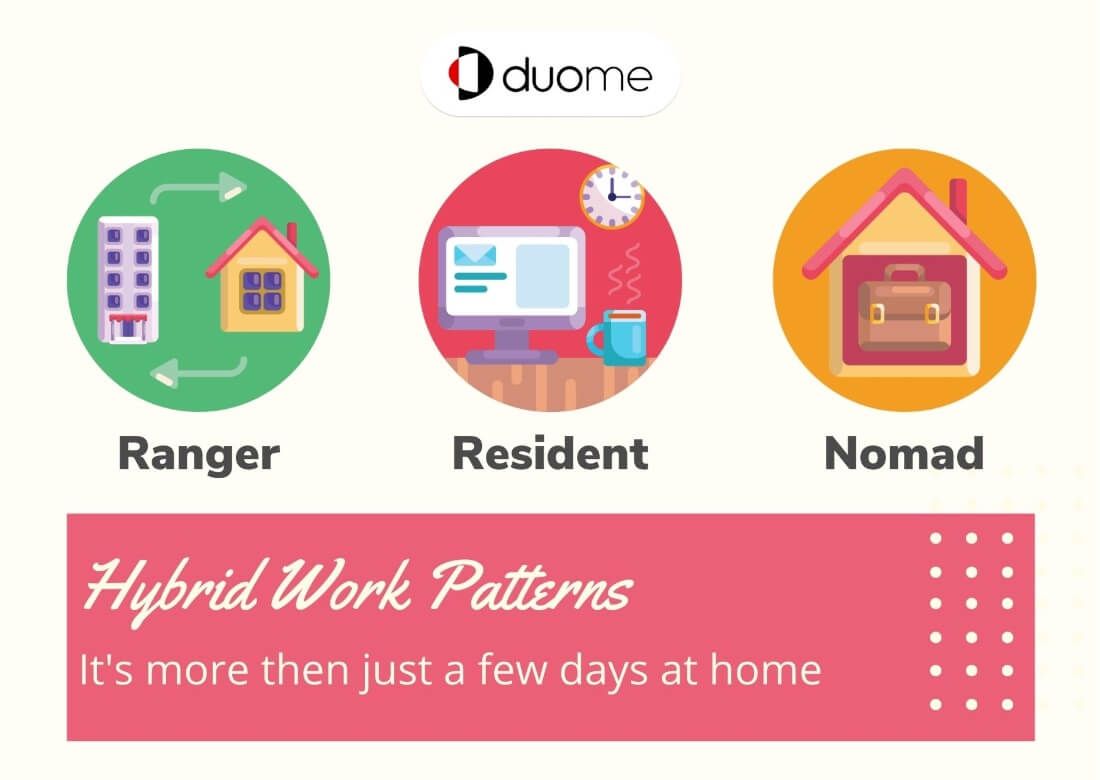One of the biggest concerns companies have when thinking about the long-term switch to hybrid working is the impact it will have on office space. Many companies are using the switch to hybrid working to reduce office space or mitigate occupancy challenges to support growth for example. To best plan, you need to model the hybrid patterns you expect to support together with occupancy of office space by day to show how many seats are required. Our hybrid working calculator does this for you and provides a model of how to think about the different workstyles you will support.

Hybrid workstyles
Hybrid working means working part of the time in the office and part of the time remotely. As organisations transition to long-term support of less time in the office, the patterns that people work are important. These are generally called workstyles, work patterns or flexible working arrangements.
It’s very likely your company will support a number of different workstyles depending on what the business needs to operate effectively whilst maintaining productive output. A number of companies are going further, allowing employees to choose their own workstyle. The most typical hybrid working patterns are either three days in the office and two at home, often referred to as 3:2, or two days in the office and three days remote (2:3).
It’s also important to recognise that many people will not be able to work remotely to perform their jobs effectively so will need to be in the office or workplace five days a week. Additionally, some people find remote working does not work well for them, they may live in a shared house with limited space for a desk or that is not sufficiently quiet across a whole working day.
A growing trend is for people to work in a third space or near home remote office as they provide the amenities and community of an office without the commute. Bars, restaurants or community spaces are also offering themselves up as third-space work locations as demand for nearer home working options increases.
Fully remote workers also need to be planned for and are likely to become increasingly common as companies continue to improve their remote working practices. Also, being remote doesn’t necessarily mean never being in the office. In fact, it often means that although an employee is not regularly scheduled to be in the office they can attend ad-hoc or at specific points in the year for training or team building.
Types of hybrid workstyles
To explain the different types of workstyle that are offered to employees, it can help to have a framework of what's offered to ease communication. One model used by many companies is Residents, Rangers and Nomads.

- Residents - those people that will be in the office full-time. This may be due to choice or role requirement but means that office space needs to be planned for them to have space all week long.
- Rangers - this is the pattern most people recognise as hybrid with people working some of the time in the office and some of the time remotely. This can be any combination of days, like 3:2 or, 2:3 or even 1:4 (office:remote). Many companies have a minimum attendance requirement in the office, for example, employees must attend the office three days per week.
- Nomads - this is for fully remote employees that don’t plan to regularly attend the office. They will still need space though for ad-hoc meetings or pre-defined office time for training or team building. Some remote workers may be truly remote and live beyond commuting distance of the office.
Office occupancy; planning for quieter days of the week
So you’ve worked out which pattern you expect people to work, but how many seats will be needed to support your new hybrid working approach? The answers are not that simple; it depends on how you plan when people will attend the office. Many companies fear the office will be empty on Mondays or Fridays unless they structure who attends the office and when.
It would be incredibly hard to hit 100% occupancy any day of the week let alone all week long to maximise the use of office space. Companies tend to run with an occupancy level measured as a percentage of available space. For example, an occupancy of 80% means 80% of the seats are occupied. Having overhead allows for demand to be smoothed and avoids people from attending the office without being able to find a space. Even with a desk booking system this still happens as people book their desks on the way to the office.
When looking to understand the impacts of changing hybrid workstyles on your required office space, a suitable method is to estimate the occupancy you can expect each day. It’s good to recognise that Mondays and Fridays will likely be less occupied than the rest of the week. Inputting this information into our calculator works out the minimum number of seats required at one point in time to be able to allocate all the different workstyles to their allotted days in the office during a week. The lower your occupancy numbers on any one day will increase the amount of space that is needed across the rest of the week.
Given the cost of office space and the general desire to reduce and downsize as we move to hybrid working, having a way to forward schedule when people plan to be in the office is essential. DuoMe for Hybrid Teams can help with the schedule of when people should be back in the office. Check it out here
Frequently Asked Questions
What is hybrid working?
Hybrid working is a type of flexible working that enables employees to work part of the week in the office and part remote. There are a number of hybrid working patterns such as three days in the office and two days remote, commonly called 3:2.
Depending on the company, the remote time may also have some flexibility of working hours as well to enable people to choose the best times of the day to perform their work.
What is a hybrid work policy?
A hybrid work policy lays out what employees can expect from hybrid working at their workplace, providing what it means for them in their role. Many companies have some conditions with moving to a hybrid work environment such as a maximum distance someone can live from the office or a minimum number of days they must attend the office each week. The hybrid working policy should clearly explain all the conditions that apply and enable the employee to understand the impact of any changes they make.
What are the benefits of a hybrid workplace?
For companies, moving to a hybrid workplace enables them to reduce the size of the office space they need to support their staff. Additionally, a number of studies have highlighted an increase in the productivity of employees. Not all work is as productive though with some companies making a point of collaborative work being more suited to in-person engagement.
For employees, the most cited benefit is the reduction of commuting time and costs. Also spending more time at home is enabling many to spend more time in the same environment as family members or pursue outside of work interests more fully.
Hybrid working calculator
Our hybrid working calculator is below, we have configured it with an example company that has 140 employees and expects the office to be 80% occupied on Mondays and Fridays and 95% the rest of the week. Change and update any of the data in the calculator to make it work for your company.








